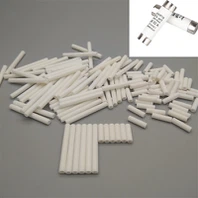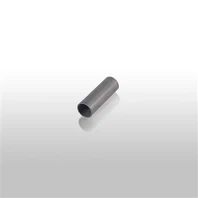Alumina ceramic can be used in the following fields:
Electrical Insulators
Alumina ceramic is widely used as an electrical insulating material due to its high dielectric strength, excellent electrical resistance, and thermal stability. It is used in applications such as spark plugs, insulators, circuit breakers, and high-voltage power transmission equipment.
Cutting Tools
Alumina ceramic's exceptional hardness, wear resistance, and high melting point make it an ideal material for cutting tools. It is used to produce inserts, blades, and wear-resistant parts for cutting, drilling, and milling operations.
Ballistic Armor
Alumina ceramic's high strength, hardness, and ability to withstand impact make it an excellent material for ballistic armor. It is used in the production of bulletproof vests, vehicle armor, and protective plates for military and law enforcement applications.
High-Temperature Furnace Components
Alumina ceramic's ability to withstand high temperatures and thermal shock makes it suitable for use in high-temperature furnace components. It is commonly used to manufacture crucibles, thermocouple protection tubes, heating elements, and furnace linings.
Wear-Resistant Components
Alumina ceramic's hardness, abrasion resistance, and chemical stability make it an ideal material for wear-resistant applications. It is used in industries such as mining, cement production, and material handling to manufacture wear-resistant liners, chutes, pipes, and pump components.
Medical and Dental Applications
Alumina ceramic is biocompatible, chemically inert, and resistant to wear, making it suitable for various medical and dental applications. It is used in the production of dental implants, prosthetics, orthopedic joint replacements, and surgical tools.
Electronic Substrates
Alumina ceramic's excellent thermal conductivity, electrical insulation properties, and compatibility with electronic components make it widely used in the electronics industry. It is used in the production of circuit boards, substrates for integrated circuits, and electronic packages.
Laser Components
Alumina ceramic's high thermal conductivity, resistance to optical damage, and dimensional stability make it an ideal material for laser components. It is used to manufacture laser reflectors, tubes, windows, and laser cavities.
Chemical and Corrosion Resistance
Alumina ceramic's resistance to chemical attack and corrosion makes it suitable for use in chemical processing equipment, corrosion-resistant linings, pumps, valves, and reactors that handle corrosive substances.
Kiln Furniture
Alumina ceramic's high-temperature resistance, thermal shock resistance, and dimensional stability make it an excellent material for kiln furniture. It is used to manufacture shelves, batts, setters, and other support structures for firing ceramics, glass, and advanced materials.
Heat Sinks
Alumina ceramic's high thermal conductivity and electrical insulation properties make it an effective material for heat sinks. It is used to dissipate heat from electronic components, such as CPUs, power transistors, LEDs, and power modules.
Ultrasonic Transducers
Alumina ceramic's excellent piezoelectric properties make it suitable for use in ultrasonic transducers. It is used in medical imaging, non-destructive testing, level sensing, distance measuring, and cleaning applications.
Oxygen Sensors
Alumina ceramic is used in the production of oxygen sensors due to its stability, resistance to high temperatures, and ability to conduct oxygen ions. It is used in automotive exhaust systems, industrial process monitoring, and medical devices.
Catalyst Supports
Alumina ceramic is commonly used as a catalyst support in various chemical reactions. Its high surface area, thermal stability, and chemical inertness make it suitable for catalytic applications in industries such as petrochemicals, automotive, and environmental engineering.
Seal Rings and Bearings
Alumina ceramic's low coefficient of friction, wear resistance, and high hardness make it suitable for use in seal rings and bearings. It is used in mechanical seals, pump components, and rotating equipment to provide reliable sealing and reduce friction.
Automotive Components
Alumina ceramic is used in the automotive industry for various applications. It is used in spark plug insulators, sensors, fuel pump components, engine components, and exhaust systems due to its high temperature resistance and electrical insulation properties.
Aerospace Components
Alumina ceramic's high strength, low weight, and resistance to high temperatures make it suitable for aerospace applications. It is used in components such as turbine blades, heat shields, insulators, and electrical connectors.
MEMS (Micro-Electro-Mechanical Systems)
Alumina ceramic is used in the fabrication of MEMS devices due to its compatibility with silicon processing techniques and its electrical insulation properties. It is used in accelerometers, pressure sensors, microvalves, and other miniaturized devices.
Thermal Barrier Coatings
Alumina ceramic-based thermal barrier coatings are used to protect components from high-temperature environments. They are applied to gas turbine blades, engine components, and exhaust systems to provide thermal insulation and improve performance.
Fuel Cells
Alumina ceramic is used in solid oxide fuel cells (SOFCs) as an electrolyte material due to its high ionic conductivity and stability at high temperatures. It enables the conversion of chemical energy to electrical energy in clean and efficient power generation systems.
Food and Beverage Industry
Alumina ceramic is used in the food and beverage industry for various applications such as grinding media, wear-resistant liners for processing equipment, and insulators for high-temperature applications.
Semiconductor Manufacturing
Alumina ceramic plays a crucial role in semiconductor manufacturing processes. It is used in wafer handling and processing components, such as wafer chucks, ceramic heaters, and insulating parts for semiconductor equipment.
Environmental Applications
Alumina ceramic is used in environmental applications such as gas and liquid filtration. It is used in filters for air purification, water treatment, and industrial processes where high-temperature and corrosive conditions are present.
Optical Applications
Alumina ceramic is used in optical applications due to its high transparency in the ultraviolet, visible, and infrared regions. It is used in lenses, windows, and optical substrates for applications such as lasers, sensors, and spectroscopy.
Nuclear Industry
Alumina ceramic's high temperature and radiation resistance make it suitable for nuclear applications. It is used in the production of fuel pellets, control rods, and other components for nuclear reactors.
Chemical Sensors
Alumina ceramic is used in chemical sensors for detecting and measuring the concentration of various gases and liquids. It is used in applications such as environmental monitoring, industrial safety, and quality control.
3D Printing
Alumina ceramic powders can be used in 3D printing to create complex shapes and structures with high precision. This allows for the fabrication of custom-designed alumina ceramic components for specific applications.
Microelectronics Packaging
Alumina ceramic is used in microelectronics packaging to provide electrical insulation, thermal management, and protection for electronic components. It is used in packages, substrates, and lids for integrated circuits, microprocessors, and other electronic devices.
Ion Implantation
Alumina ceramic is used as a target material in ion implantation processes, where ions are implanted into semiconductor materials to modify their electrical properties. Alumina ceramic targets provide a stable and reliable source of ions for the implantation process.
X-ray Tubes
Alumina ceramic is used in X-ray tubes as a high-voltage insulator and structural component. It provides electrical insulation and structural support for generating and controlling X-rays in medical and industrial imaging applications.
Textile Industry
Alumina ceramic is used in the textile industry for applications such as yarn guides, thread guides, and eyelets. It provides wear resistance and smooth surfaces for efficient thread guidance and reduced friction.
Abrasive Applications
Alumina ceramic can be used as an abrasive material for grinding, polishing, and surface finishing applications. It is used in grinding wheels, abrasive belts, and abrasive powders for metal, glass, and ceramic processing.
Fluid Handling Systems
Alumina ceramic is used in fluid handling systems where resistance to abrasion, corrosion, and high temperatures is required. It is used in valves, pumps, nozzles, and impellers for applications such as chemical processing, mining, and wastewater treatment.




